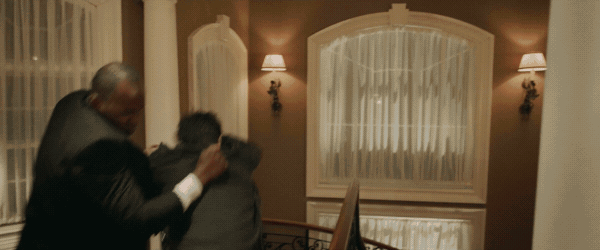Directing team John Francis Daley and Jonathan Goldstein bring a great sense of play to their work. This is dramatised rather literally in this delightful sequence in Game Night (2018) — which we name check in our latest Draft Zero episode on “The Game of the Scene” (#shamelessplug).
It’s a masterclass of some really clever filmmaking techniques.
“A high-stakes game of hot potato”.
This article was originally published on Aug 31, 2023, but has now been expanded by a breakdown over on your YouTube Channel. And we’ve added some additional detail about the location work below.
The Breakdown
The Full Sequence
This great little sequence is written in the script as:
The Oner
The centrepiece of the sequence is a oner. The sense of space and time that it gives makes the thing feel both more game-like and more intense. Because we’re crazy at Shot Zero, we actually did a rough camera plot based on the floorplans of the location:
The Location
The sequence was shot on a real-world location which helps make al the lunacy feel grounded. As production designer Michael Corenblith explains in Interiors1:
A newly built mansion in the suburbs north of Atlanta provided every capability and opportunity we could imagine. The house was centered around a three story tall atrium, that had multiple stairways and balconies with generous apertures and sight-lines between the spaces around the atrium. The directors could see the potential that the location afforded them, but the actual nuts-and-bolts of figuring this out could now include the Cinematographer, Barry Peterson, and the Stunt Coordinator, Steven Ritzi.
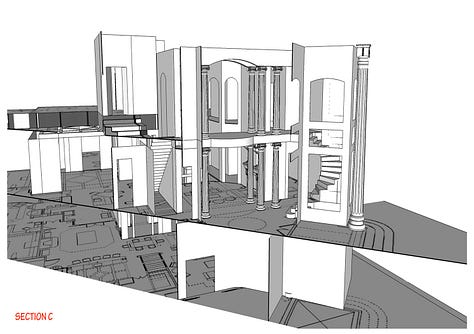
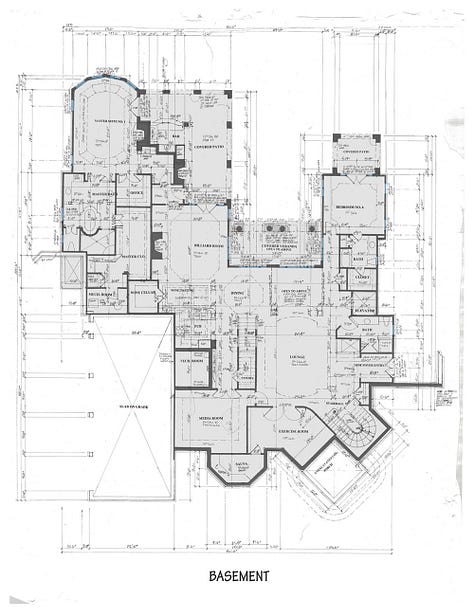

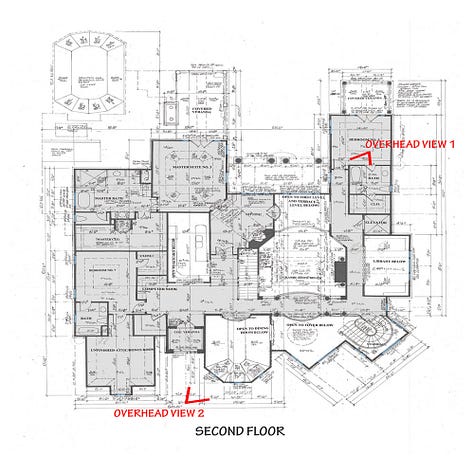
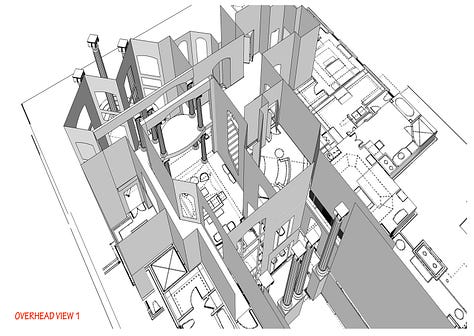

The Visual Language
The visual language of the oner is artfully set up by this 90° tilt up that recalls the David Fincher of Panic Room and Fight Club. We’re being shown that the camera will not be coupled to the characters. It has its own perspective: knowing just where to be.
Art Director, Danny Brown, was able to take the architect’s plans for the house, and use them to create low-definition SketchUp models, that were used by the Directors, Cinematographer, and Stunts in laying out the basics of the choreography and camera movements.
You can see the same idea in this “breakaway” moment: we leave the character we’re following to find one of the Bad Guys. It creates a moment of suspense — “oh no, she’s going to get caught” — but then surprise! she enters frame and turns on her heels.
The oner itself is stitched together from multiple sub shots. Some of it shot on a gimbal:
And some of it shot on a cable-camera:
Each sub-shot is (I reckon) built around the appropriate bit of grip kit for getting the camera move they wanted. The end effect is that the changing of the type of camera movement makes the whole sequence really dynamic and kinetic.
Eagle-eyed readers may notice that in the first GIF that Ryan (Billy Magnussen) is holding a physical Fabergé egg. While in the second GIF, Max (Jason Bateman) is catching… well… nothing.
CGI eggs would explain the perfect passes between the characters. Not having to take perfect catches on camera would make it much faster to shoot.
You can see the CGI egg bounce around in Jason Bateman’s hands. But who cares? It happens so quick and is quickly obscured by the door.
Jason continues to obscures his hands from the camera - so we can’t see what, if anything, he’s holding - until he ends up falling over and letting it go…
And we don’t even see him let go of the egg in shot! (Kind of a reverse Texas switch?)
Because the rolling egg is CGI (so they can choreograph it to perfection) and those kinds of interactions between CGI objects and live-action human hands are tough: you’ll end up doing CGI hands too. And, understandably, people tend to be a lot more sensitive to the realism of human digi-doubles than to digi-double Fabergé eggs.
The “layout” of this sub shot (the choreography of the animation and camerawork) feels grounded because the framing isn’t quite perfect. As if the camera operator can’t quite predict where the egg where will be.
Compare it to this iconic shot from Fincher’s Panic Room where the CGI mobile phone stops perfectly in frame. It feels more artificial, even if there’s a subtle tilt mid-shot.
If you rewatch the whole “hot potato” sequence again, notice how the filmmakers been very careful to hide the moment of transition from a CGI egg to a physical egg and vice versa. They’re kind of modern variations of classic Texas switches2.
We don’t see eggs being BOTH thrown and caught in frame, we see one or the other (except for the short pass at the start).
It’s own kind of fun game to try and work out where these texas switches and shot stitches are. Its very clever stuff!
John Francis Daley and Jonathan Goldstein build on these ideas in the “doric chase” in Dungeons & Dragons: Honor Among Thieves (2023) which we will look at soon!










